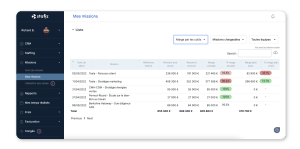Quels coûts liés au staffing peuvent être réduits ?

Dans de nombreux cabinets de conseil, la charge est distribuée “au mieux”, sous la pression du planning, plutôt qu’en fonction des compétences réellement mobilisables. Mais quand une ressource est inadaptée au projet, la productivité se dégrade, et les écarts se creusent entre le prévisionnel et le réel. Problème : ces coûts supplémentaires ne sont pas toujours visibles dans les rapports.
Jour après jour, vous voyez votre marge glisser sans comprendre immédiatement où elle se perd. Votre PMO se retrouve à multiplier les arbitrages d’urgence. Vos consultants, eux, basculent entre surcharge et intercontrats (ou bench time). Un mauvais staffing finit toujours par coûter cher et représente en moyenne plusieurs points de marge brute sur une année.
En revanche, les ESN et cabinets de conseil qui savent positionner les bonnes personnes au bon endroit, en tenant compte de leur charge réelle et des compétences disponibles améliorent nettement leur ROI. C’est par exemple le cas de Cegid qui a récupéré 3 points de marge brute en douze mois grâce à un pilotage centralisé du staffing et une meilleure allocation des ressources.
Dans cet article nous vous montrons comment mesurer le coût de votre staffing, mesurer l’impact des coûts cachés sur votre business, et comment mieux allouer vos ressources et sécuriser vos marges.
Quels sont les coûts associés au staffing ?
Les coûts du staffing se répartissent entre des dépenses visibles (temps de gestion, outils, coordination…) et des coûts cachés liés aux écarts entre besoins réels et allocation des ressources. Ces écarts impactent directement la productivité des ressources, la marge projet et la capacité à suivre le taux d’utilisation des consultants.
Quels sont les coûts fixes ou “attendus” du staffing ?
Les coûts fixes du staffing regroupent les dépenses directement liées à la gestion quotidienne des ressources. Ils incluent notamment :
- le TJM des personnes responsables de la gestion : les responsables de staffing, managers opérationnels, chefs de projet ou PMO doivent planifier, ajuster et suivre les affectations ;
- les coûts matériels : logiciels de planning, suivi des temps, congés ou gestion des affectations.
Dans une ESN, le coût fixe du staffing peut ainsi représenter plusieurs dizaines de milliers d’euros par an, même lorsque les processus sont bien structurés.
Quels sont les coûts cachés du staffing et comment les détecter ?
Ces 6 coûts cachés du staffing représentent la face invisible du pilotage des projets.
- Mauvais matching des compétences : le profil affecté ne dispose pas des compétences nécessaires au projet. Le travail progresse plus lentement et ses tâches devront potentiellement être reprises ;
- Sous-staffing : l’équipe ne peut pas absorber l’ensemble des tâches, entrainant de la fatigue chez les collaborateurs, et pouvant se transformer en absentéisme et en turnover. Pour le cabinet, cela se traduit par des retards, des heures non prévues et une perte de fiabilité dans la livraison ;
- Sur-staffing : trop de personnes ou des personnes trop qualifiées sont affectées au projet. Leur TJM n’est pas compensé par la valeur crée, alors que le TACE diminue ;
- Mauvaise anticipation de l’intercontrat : la gestion des ressources inter-mission consulting impacte directement la marge projet et la rentabilité par consultant ;
- Manque de visibilité sur les disponibilités : faute d’une vision consolidée des disponibilités, les arbitrages sont pris trop tard et se traduisent souvent par un recours d’urgence à la sous-traitance, ou le refus de missions pourtant rentables ;
- Outils déconnectés : un pilotage éclaté entre plusieurs fichiers ou plateformes génère des saisies multiples, une perte de fiabilité des données et des erreurs de planification.
Ces coûts expliquent une large partie des écarts entre le prévisionnel et le réalisé d’un projet. Malheureusement, ils sont difficilement visibles dans les rapports.
Pour les révéler et agir avant qu’ils ne s’accumulent, les cabinets s’appuient sur un système intégré (comme Stafiz) qui relie staffing, charge de travail, disponibilité, facturation et marge à terminaison. Les dérives deviennent des alertes exploitables et des leviers de performance mesurables.
Quels sont les coûts cachés du staffing directement liés aux ressources humaines ?
Vos décisions de staffing ont un impact direct sur votre performance RH. Chaque erreur d’affectation, chaque rupture de période d’essai ou chaque démotivation liée à un mauvais positionnement crée des coûts en cascade : perte de productivité, délais supplémentaires, surcharge managériale, départs anticipés… La capacité à fidéliser et à anticiper les besoins en compétences repose sur une prévision des ressources qui aligne charge, disponibilité et évolution des collaborateurs. C’est l’une des clés pour limiter les pertes financières.
Quels sont les enjeux financiers d’un bon recrutement ?
Selon le Mercato de l’Emploi, une erreur de recrutement représente un coût direct de 20 000 à 50 000 € (publication de l’annonce, passage des entretiens, formation et versement des indemnités éventuelles).
Ces coûts sont amplifiés dans les ESN et cabinets de conseil, où chaque collaborateur porte un portefeuille projet et un potentiel de facturation. Dans certains cas, cette perte s’élève jusqu’à 150 000€ par recrutement raté en intégrant des coûts indirects tels que :
- un refus de poste entraîne un décalage du démarrage du projet une réorganisation forcée du staffing et une fragilisation de la relation client ;
- une rupture pendant la période d’essai, laquelle aura mobilisé plusieurs managers et experts pour former le nouveau venu, et nécessite de relancer un recrutement ;
- un recrutement à reconduire incluant une nouvelle campagne de sourcing, de sélection et d’onboarding, ainsi qu’une surcharge des équipes qui doivent temporairement absorber la charge du poste vacant.
- les opportunités commerciales non saisies, faute de disposer des compétences disponibles au bon moment.
L’importance de l’évolution professionnelle des salariés
L’engagement d’un collaborateur dépend largement de la cohérence entre ses missions et le développement de ses compétences. Que se passe-t-il lorsqu’un consultant n’est pas positionné sur les projets adaptés à son expertise ou à son parcours ?
- Il n’est pas suffisamment engagé dans son travail, car le projet ne correspond pas à ses compétences ou son plan de carrière. Cela entraîne une baisse de la qualité des rendus, une baisse de productivité et un besoin de formation pour rattraper les écarts de compétence.
- Il risque de vouloir partir par lassitude, ce qui va représenter une perte de savoir-faire pour le cabinet et une rupture de continuité sur ses projets. De plus, il faudra un temps significatif avant que son remplaçant n’atteigne le même niveau de performance.
Comment réduire les coûts liés au turnover ?
Lorsque les besoins en compétences sont bien anticipés, les coûts liés aux départs des salariés (perte de productivité, nouveaux recrutements, surcharge des équipes) diminuent fortement. La clé : disposer d’une vision fiable des compétences, des aspirations professionnelles et de la charge pour ajuster le staffing en continu.
Les KPI à suivre
Certains indicateurs permettent de repérer les risques de désengagement avant qu’ils ne se transforment en départs coûteux. Ils s’intègrent directement dans le pilotage du staffing.
- La durée par collaborateur sur la même mission : une présence prolongée sur un seul projet peut générer de la lassitude et une baisse d’engagement. Favoriser une rotation maîtrisée expose le collaborateur à d’autres contextes et accélère sa progression, tout en renforçant sa rétention.
- Les souhaits de compétences à mobiliser : recueillez les compétences que le collaborateur souhaite développer pour orienter ses futures affectations. L’information est ensuite intégrée au staffing, lorsque les contraintes de charge et de budget le permettent.
- La possibilité de juniorisation : cet indicateur identifie les missions sur lesquelles un profil junior peut remplacer un senior. Cet intérêt est double : accélérer la montée en compétence des profils juniors et mobiliser les seniors sur des sujets experts à plus forte valeur ajoutée.
- Les écarts entre les compétences et les besoins permettent de révéler les tensions futures en termes de formation, recrutement anticipé et re-staffing.
Pour limiter les coûts associés à ces risques RH, les équipes ont besoin d’être en mesure de prévoir leurs besoins en ressources et en compétences
Le processus en pratique
Parmi les pratiques les plus efficaces observées lors de nos accompagnements client :
- Revue hebdo sur la durée passée sur les missions : programmer des alertes automatiques en cas de dépassement permet d’aborder les blocages au plus tôt et de réajuster le staffing et d’éviter que l’insatisfaction ne s’installe.
- Matching entre besoins ouverts et collaborateurs : visualiser la charge et les disponibilités de manière consolidée accélère l’identification du bon profil. Les recherches manuelles chronophages disparaissent, et les oublis de profils pertinents sont évités.
Identifiez les profils les plus adaptés à chaque projet
Voyez Stafiz en action en 2 minutes
- Approche “carrière” et upskilling : afin de favoriser la mobilité interne et la satisfaction des employés, mettre en place des micro-parcours de 2 à 4 semaines pour combler les gaps sur les attentes clients et retenir les profils clés.
- Mettre à jour les souhaits des collaborateurs concernant les compétences à mobiliser chaque trimestre : bien que ça ne soit pas toujours possible à prendre en compte en raison des priorités qu’impose le staffing (respecter les délais et le budget), intégrer les appétences des collaborateurs dans le processus est un bon réflexe : une trace écrite permettra de donner une suite contrairement à un échange oral.

Stafiz permet de l’indiquer dans le profil des collaborateurs afin qu’ils puissent ressortir lors de l’affectation des profils par les responsables, ou pour notifier d’eux même qu’un projet les intéresse.
Questions fréquentes :
Les coûts de recrutement incluent à la fois les coûts directs (publication d’offres, frais d’agence ou honoraires de chasseurs de têtes, outils d’évaluation) et les coûts indirects (temps passé par les équipes, traitement des candidatures, entretiens, intégration et formation). Ensemble, ils représentent un investissement conséquent pour chaque embauche.
Le coût d’une erreur de recrutement — lorsqu’un employé quitte ou est licencié peu après son arrivée — est particulièrement élevé, atteignant souvent plusieurs mois de salaire du poste. Il comprend la perte de l’investissement initial (recrutement, onboarding), la baisse de productivité, le temps consacré à la gestion de la sortie, et le redémarrage complet du processus. À cela s’ajoute un impact potentiel sur le moral et la cohésion des équipes.
Le refus d’un candidat qualifié entraîne un coût d’opportunité important et retarde le recrutement. Il nécessite de relancer la sélection ou de contacter d’autres candidats, augmentant le temps et les coûts associés. Si le refus découle d’une mauvaise expérience candidat, cela peut aussi nuire à la marque employeur, rendant les recrutements futurs plus difficiles et plus coûteux.
Manque de visibilité sur le capacity planning : ce qu’il en coûte
Un pilotage du staffing sans vision claire de la capacité actuelle et future expose votre entreprise à des risques financiers majeurs : dégradation des marges, perte de productivité, opportunités commerciales manquées…. Sans données fiables sur la charge et les disponibilités, chaque décision se fait en réaction des aléas rencontrés lors du projet, et est donc plus coûteuse.
Cette visibilité manquante entraîne une mauvaise planification des ressources projets et empêche de suivre correctement le taux d’utilisation des consultants. À terme, cela se traduit par des coûts non facturables inutiles et une dilution de la marge projet staffing.
L’enjeu d’une visibilité totale sur la capacité actuelle…
Sans visibilité en temps réel sur la capacité des équipes, il devient impossible d’identifier qui est réellement sous-staffé ou sur-staffé.
- Le sous staffing représente un risque de burn-out et baisse la rétention, car la charge excède la capacité disponible.
- Le sur-staffing représente un risque de bore-out, associé à une démotivation progressive et un risque de départ des salariés..
Une bonne visibilité sur la capacité totale et en temps réel contribue à diminuer le risque lié au turnover, et d’éviter les recrutements en urgence ou la sous-traitance, souvent coûteux. Cette vision macro vous indique si :
- La compétence est réellement indisponible ;
- La compétence est actuellement mobilisée sur une mission moins prioritaire ;
- La compétence peut être acquise par un collaborateur à l’issue d’une formation courte.
Une bonne gestion des compétences participe à réduire les coûts du staffing et améliore la qualité des arbitrages.
… et d’une vue sur les disponibilités à venir
L’absence de visibilité sur les disponibilités futures affecte directement votre chiffre d’affaires futur. Si vous ne pouvez pas anticiper quand votre capacité est inférieure aux besoins clients, vous risquez de vous retrouver en sous-effectif sur un profil clé au pire moment. Faute d’avoir calibré vos besoins plus tôt (formation, recrutement, sous-traitance), certaines missions rentables devront être refusées.
Lorsque l’équipe commerciale ne sait pas quand une compétence sera à nouveau disponible, elle ne peut :
- ni planifier la signature,
- ni sécuriser le démarrage,
- ni promettre un planning cohérent, car la disponibilité des ressources n’est pas connue.
Une charge prévisionnelle fiable permet d’anticiper les creux et pics d’activité plusieurs semaines à l’avance, ce qui réduit drastiquement les arbitrages tardifs et les refus de mission évitables. Cette vision prévisionnelle des disponibilités permet :
- d’enclencher une formation avant que la compétence ne manque,
- de programmer un recrutement avant que la situation ne devienne critique.
Les cabinets qui disposent de cette visibilité transforment un pilotage réactif en pilotage stratégique : ils vendent ce que les équipes peuvent réellement délivrer, au moment où elles peuvent le faire, et stabilisent leur prévisionnel tout en préservant leur rentabilité par projet et staffing.
Quel est l’impact du TACE sur la rentabilité ?
La visibilité sur la charge sur les projets permet d’anticiper les risques de dépassement et donc de préparer de manière proactive les négociations afin d’éviter des pertes sur la marge. Un outil dédié permet également de suivre le taux d’utilisation des consultants, en mettant à jour automatiquement le temps facturable et non facturable pour anticiper les déviations de marge. Le suivi du taux de charge offre également une compréhension fine de la productivité horaire réelle des consultants, en révélant la proportion exacte de temps valorisé.
Plus on donne la visibilité tôt sur les risques de déviations, plus le client sera apte à négocier plutôt que de constater le retard ou les coûts en fin de projet
Augmenter les taux de charge pour diminuer les coûts
En France, le taux de staffing moyen se situe autour de 78%, c’est-à-dire que la majorité du temps du consultant passé sur des activités facturables. Avec un meilleur suivi de la charge, il est possible de viser au-delà de 80 %, et nos clients atteignent régulièrement 85% grâce à un pilotage fin du staffing.
Augmenter son TACE de +3 à +5 points suffit à dégager plusieurs centaines de milliers d’euros de chiffre d’affaires additionnel, sans recruter. Pour y parvenir, nous mettons en place 3 leviers d’action dans Stafiz.
Un dashboard en temps réel
Ce tableau de bord vous aide à comprendre en temps réel :
- où se concentre la charge ;
- les cas de sous-staffing,
- les situations de surcharge (dans le “rouge”),
- les risques à venir pour les prochaines semaines.

Dans Stafiz, les cas de sous ou de surcharge sont facilement identifiables.
Attention : la charge non facturable doit impérativement être exclue pour ne pas fausser l’analyse et permettre des arbitrages en un coup d’oeil.
En faire un outil de revue hebdomadaire
Une revue hebdomadaire des taux passés et prévisionnels permet :
- de mesurer l’écart entre l’objectif et la trajectoire réelle d’un projet ou d’un portefeuille projet ;
- d’identifier les performances par équipe ou par département ;
- d’ajuster le staffing avant que le TACE ne s’effondre ;
- d’alimenter les managers avec des données fiables pour piloter leurs projets.
Cette revue transforme les indicateurs de charge en outil d’action, pas seulement de reporting.
Structure qui mélange les équipes avec le cross staffing
Mélanger les équipes facilite l’utilisation optimale des compétences et réduit la dépendance à la sous-traitance. Organiser des réunions de staffing permet de faire matcher les besoins entre les différentes missions ou équipes.
Cas d’usage client : +5 points de taux de charge en 10 semaines
Ce cabinet de conseil de 400 collaborateurs, présent en France et à l’international, faisait face à un manque de visibilité sur sa charge et ses disponibilités.
Objectif : s’assurer que chaque division dispose des profils cibles au bon moment, grâce à un processus formalisé de demande et d’allocation des ressources.
Gagnez des points de staffing dès aujourd’hui
Que représente une augmentation de 3 points de staffing ?
Imaginez une entreprise de 100 collaborateurs travaillant 220 jours par an pour un TJM de 1000€.
Augmenter le taux de staffing de 3 points signifie augmenter le nombre de jours facturables de 3%. Dans notre exemple, un gain de 3 points de staffing génère +660 000 € de chiffre d’affaires additionnel par an :
- Jours facturables supplémentaires par collaborateur :
220 × 3 % = 6,6 jours - Pour 100 collaborateurs :
6,6 × 100 = 660 jours - Chiffre d’affaires additionnel :
660 × 1 000 € = 660 000 € / an
+3 points de staffing = 3 % de jours facturables en plus, donc plus de chiffre d’affaires, sans recruter ni augmenter les coûts fixes, soit plusieurs centaines de milliers d’euros de CA supplémentaire, uniquement grâce à une meilleure allocation des ressources.
L’impact financier d’une mauvaise gestion du staffing
Une mauvaise prévision des ressources projet vous empêche d’avoir une vision claire de la répartition entre activité facturable et non facturable. Impossible d’anticiper la productivité des consultants ; et, par extension, de projeter votre chiffre d’affaires.
Sans une vision précise du coût réel d’une ressource projet, il est impossible de piloter efficacement sa marge, ni de réduire les coûts non facturables liés au staffing. Cette situation crée deux problèmes majeurs.
- Incapacité à comprendre où se trouve réellement la charge : Si plusieurs collaborateurs travaillent sur des projets internes au même moment, sans visibilité globale, l’entreprise ignore que sa capacité facturable baisse. Cela entraîne des arbitrages tardifs, des “périodes creuses” mal gérées et des ressources indisponibles pour répondre aux opportunités commerciales – alors même qu’elles sont sur une mission non prioritaire.
- Mauvaise gestion du non-facturable : La visibilité sur la charge non facturable est un levier critique pour optimiser le TACE. Elle permet notamment de maintenir les consultants prioritairement sur des projets facturables et de planifier les activités internes (formation, R&D, organisation, support) dans des périodes stratégiques, cohérentes avec la saisonnalité de l’activité.
Un pilotage précis de vos ressources vous permet de réduire les heures non facturables et d’améliorer la marge de votre société de gestion. Cette gestion de la charge non facturable est centrale en gestion de projet : sans distinction claire entre charge productive et charge interne, il devient impossible d’optimiser la rentabilité et d’allouer efficacement les ressources.
Le bon processus
Voici 3 bonnes pratiques pour transformer le staffing en levier de rentabilité.
- Calcul de tous les KPI “à terminaison” : vous devez prendre en compte ce qui a déjà été réalisé, le reste à faire (coûts internes) et être capable de calculer votre maje nette, meême en cas d’achats ou de frais supplémentaires.

Suivi des marges par les coûts à terminaison dans Stafiz pour un rapport de rentabilité fiable en temps réel
- Mise à jour du planning de charge régulièrement par le chef de projet (généralement chaque semaine ou chaque mois) afin d’obtenir une projection fiable des coûts et une visibilité consolidée sur la charge des collaborateurs.
- Utiliser des alertes automatiques pour agir avant que le projet ne dérive. Si l’alerte prévient que la marge projetée risque de dévier de 15%; le chef de projet et le manager de la practice sont immédiatement prévenus et peuvent agir en anticipation.
Ces alertes créent de la proactivité et protègent la marge avant qu’elle ne s’érode, ce qui n’est pas négligeable pour garantir la rentabilité des missions
Cas d’usage client
Cet intégrateur de logiciels Cegid avec 115 collaborateurs souffrait d’un manque de visibilité sur ses marges projet et d’un pilotage trop réactif. Après 12 mois d’utilisation de Stafiz, l’entreprise a récupéré +3 points de marge brute, grâce à ces 3 leviers.
- Planning de charge mis à jour mensuellement : la marge à terminaison est recalculée en continu, offrant une visibilité précise sur l’évolution par rapport au budget initial.
- Intégration des objectifs de marge dans les bonus : les chefs de projet sont directement informés des objectifs financiers associés à leurs projets, ce qui assure une cohérence entre suivi opérationnel et attentes budgétaires.
- Alertes automatiques : les risques de dérive sont détectés à l’avance et remontés immédiatement à la direction, permettant des actions correctives rapides.
Revue mensuelle des atterrissages des portefeuilles de projet : cette visibilité à long terme permet au cabinet de négocier plus tôt avec les clients pour corriger les surcharges de travail et rééquilibrer la charge avant qu’elle n’impacte la marge.
Que représente +1pt de marge brute ?
+1 point de marge brute = 1 % de votre chiffre d’affaires en rentabilité supplémentaire, sans embaucher et à périmètre constant. C’est pourquoi gagner même 0,5 point de marge rien qu’en reprenant le contrôle son staffing peut représenter une énorme amélioration selon la taille de l’entreprise.
Comment un outil de staffing peut-il aider à maximiser la rentabilité ?
Un outil de staffing pour société de conseil transforme complètement la manière dont les ESN et cabinets de conseil pilotent leur charge, leurs compétences et leurs marges. Grâce à une gestion de portefeuille de projets centralisée, les décisions de staffing ne se prennent plus projet par projet, mais à l’échelle de l’ensemble du delivery, ce qui améliore immédiatement la cohérence des arbitrages et la rentabilité globale.
Résultat : des décisions plus fiables, moins d’imprévus, et une rentabilité par projet mieux protégée.
Grâce à une visibilité totale sur les projets
Un outil de staffing centralise toutes les données essentielles pour piloter la charge :
- distinction claire entre charge facturable et non facturable ;
- vision consolidée de la disponibilité et des affectations ;
- mise à jour automatique des informations clés (charge, congés, intercontrat, sous-traitance).
En interfaçant avec le CRM, l’ERP et le SIRH, la plateforme offre une vue 360° des projets :
- côté commercial : disponibilité réelle des compétences pour valider une proposition,
- côté finance : vision claire des marges prévisionnelles et des coûts internes,
- côté RH : compétences, niveaux et évolutions intégrées au staffing.
Cette unification permet de générer automatiquement des indicateurs de rentabilité projet, à suivre en temps réel ou en prévisionnel. Les responsables peuvent ainsi anticiper les dérives, ajuster la charge et négocier avec le client avant que la marge ne soit impactée.
Grâce à des fonctionnalités proactives…
Un outil spécialisé comme Stafiz ne se contente pas de centraliser les données : il vous permet d’agir plus vite et plus tôt grâce à ces deux fonctionnalités.
- Comparer prévisionnel vs réalisé : les écarts de charge, de coût ou de planification apparaissent immédiatement, sans attendre la revue mensuelle. Lorsqu’un projet commence à consommer davantage de charge que prévu ou qu’une disponibilité évolue, l’alerte remonte en temps réel. Les ajustements peuvent alors être faits progressivement, plutôt que de corriger brutalement une dérive devenue trop importante.
- Automatiser les affectations : l’outil analyse les compétences requises, les disponibilités, les préférences des collaborateurs et les contraintes de charge pour proposer les meilleurs profils en quelques secondes, ce qui élimine les “errances” de staffing.
… qui permettent une meilleure planification de projet
L’ensemble de ces fonctionnalités transforme la planification des projets. En regroupant toutes les données dans un seul outil, les entreprises disposent d’une vue fiable et partagée qui facilite les décisions à court, moyen et long terme. Cette consolidation des données rend possible d’optimiser la planification des ressources projets, en garantissant que chaque compétence est mobilisée au bon moment et au bon coût.
Le pilotage du taux d’utilisation devient plus précis : chaque manager visualise en temps réel le temps facturable, les heures non facturables et les périodes d’intercontrat. Cette transparence permet de mieux répartir la charge et d’éviter les déséquilibres entre équipes.
L’outil facilite également la gestion du bench time d’une société de conseil. Les collaborateurs en fin de mission sont identifiés à l’avance, ce qui laisse le temps d’anticiper leur prochain positionnement : activation commerciale, recherche interne, passage sur un autre projet, ou montée en compétences. Résultat : moins de bench subi, et plus de mobilité interne.
La planification peut se faire avec une granularité adaptée : en jours pour les missions au forfait, en heures pour les projets en régie ou les interventions ponctuelles. L’outil permet aussi d’intégrer la sous-traitance dans la même vue que les ressources internes, ce qui élimine les angles morts et réduit les décisions biaisées par une vision incomplète de la capacité réelle.
Conclusion : ce qui n’était qu’un processus administratif chronophage devient un véritable levier stratégique. Le staffing aligne enfin les capacités opérationnelles sur les ambitions commerciales de votre ESN, sécurise la marge et contribue directement à la performance globale de votre entreprise. Une gestion structurée du staffing devient ainsi un levier majeur de performance et de rentabilité pour un cabinet de conseil, bien au-delà d’un simple exercice administratif.
Questions fréquentes :
Le coût réel est obtenu en multipliant les heures saisies par le taux de revient interne (salaire chargé + frais fixes) de la ressource. Comparer ce coût réel aux revenus forfaitaires permet ensuite de calculer la marge brute du projet et d’identifier les éventuelles dérives.
L’onboarding et la formation mobilisent du temps de collaborateurs expérimentés et entraînent une baisse de productivité temporaire du nouvel arrivant. L’inadéquation des compétences génère des erreurs, du travail supplémentaire, des retards et une qualité moindre des livrables, ce qui crée des coûts additionnels pour corriger ou rattraper le niveau attendu.
Un outil de staffing augmente la marge en optimisant l’affectation des ressources les plus adaptées et les moins coûteuses disponibles. Il maintient un taux d’utilisation élevé en détectant et comblant rapidement les périodes de sous-charge. Grâce aux données précises sur les coûts réels, il aide aussi les chefs de projet à ajuster les tarifs de facturation et à limiter les dérives budgétaires.


